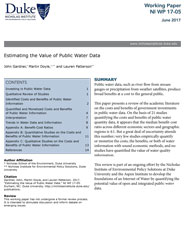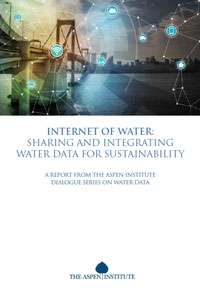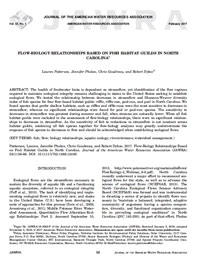Publications
Managing Rivers Under Changing Environmental and Societal Boundary Conditions, Part 2: Expected Compared With Experienced Conditions at U.S. Army Corps of Engineers Reservoirs
Reservoirs are critical infrastructure typically built to function as designed for 50 to 100 years. The majority of U.S. Army Corps of Engineers reservoirs are more than 50 years old. The environmental, societal, and regulatory conditions surrounding the reservoir, that is, the reservoir's expected conditions, shaped its design. Many of these expectations assumed a future similar to the past. However, recent decades have experienced warming climates, cyclical changes in precipitation, the introduction of new regulations, and populations concentrating in urban environments.
Addressing Declining Appropriations for Bureau of Reclamation Infrastructure: Policies Needed for Enabling Private Finance
Western water infrastructure was funded in the early and mid‐20th Century with federal financing through the Bureau of Reclamation. Over the last 30 years, federal financing has been less forthcoming, which has been commensurate with an increase in the need for financing rehabilitation and replacement of western irrigation infrastructure. This article in the Journal of the American Water Resources Association suggests that if the Office of Management and Budget changed its policies for private partnerships or loan guarantees, private capital could play an important role in recapitalizing aging Reclamation infrastructure.
Leveraging Big Data Towards Functionally-Based, Catchment Scale Restoration Prioritization
To address limitations to stream and wetland restoration projects, there is a critical need for a functionally-based, high-resolution restoration priority system that can be implemented at broad spatial scales to maximize ecological benefits. This article in the journal Environmental Management describes the River Basin Restoration Prioritization tool developed in conjunction with the North Carolina Department of Environmental Quality to incorporate data models into a catchment scale restoration prioritization framework. It is designed specifically as a state-wide screening tool that assesses hydrologic, water quality, and aquatic habitat quality conditions with peak flood flow, nitrogen and phosphorus loading, and aquatic species distribution models. Although the application of the tool in this analysis is for the state of North Carolina, the methodology and model datasets are readily applicable to other states or regions to assess a large volume of data to better inform restoration choices.
The Value of Water Information: Overcoming the Global Data Drought
This paper is a call to action for data users, data providers, and global decision makers concerned about water resources, climate resilience, and sustainable development. It provides an overview of hydrological monitoring systems and explains the importance of public water data to national governance, resource management, planning, and efforts to achieve global objectives such as the Sustainable Development Goals.
Creating Data as a Service for U.S. Army Corps of Engineers Reservoirs
In the United States, our water data infrastructure does not allow us to consistently and quickly answer the most basic questions about our water system’s quantity, quality, and use. This report describes the challenges and opportunities of integrating U.S. Army Corps of Engineers 36 districts’ historic reservoir data and management operations. A companion tool to visualize data as well as the data files related to this report are available to view and download. Research by the authors to identify the frequency and magnitude of departures from operational targets of Army Corps-operated reservoirs is presented in the Journal of the American Water Resources Association.
A Nationwide Analysis of U.S. Army Corps of Engineers Reservoir Performance in Meeting Operational Targets
The U.S. Army Corps of Engineers operates reservoirs across the United States. Most (89 percent) of the reservoirs were constructed prior to 1980, and many have experienced changes in environmental conditions such as climate and sediment yield and societal conditions such as water and energy demand. These changes may challenge the potential for reservoirs to meet their operational targets and management goals. To identify the frequency and magnitude of departures from operational targets, this analysis published in the Journal of the American Water Resources Association collected Army Corps reservoir targets and historic daily reservoir data for 233 reservoirs. This work provides a framework to identify reservoir performance in relation to management goals, a necessary step for moving toward adaptive management under changing conditions. Individual reservoir analyses are accessible through an interactive data visualization tool. Companion research by the authors on Army Corps-operated reservoirs is presented in the report, Creating Data as a Service for U.S. Army Corps of Engineers Reservoirs.
Estimating the Value of Public Water Data
Public water data, such as river flow from stream gauges or precipitation from weather satellites, produce broad benefits at a cost to the general public. This paper presents a review of the academic literature on the costs and benefits of government investments in public water data. On the basis of 21 studies quantifying the costs and benefits of public water quantity data, it appears that the median benefit-cost ratio across different economic sectors and geographic regions is 4:1. But a great deal of uncertainty attends this number; very few studies empirically quantify or monetize the costs, the benefits, or both of water information with sound economic methods, and no studies have quantified the value of water quality information. This review is part of an ongoing effort by the Nicholas Institute of Environmental Policy Solutions at Duke University and the Aspen Institute to develop the foundations of an Internet of Water by quantifying the potential value of open and integrated public water data.
Internet of Water: Sharing and Integrating Water Data for Sustainability
This report from the Aspen Institute Dialogue Series on Water Data lays out a vision for a national policy framework that addresses institutional barriers to increasing integration of water data and information to support sustainable water management. In the United States, data to manage water supplies and pursue innovative solutions to meet water management challenges are lacking or are not in a format that is easily accessible or understandable, and there are often strong disincentives, fears, and concerns about sharing the data. To address this challenge, the Aspen Institute Energy and Environment Program in partnership with the Nicholas Institute for Environmental Policy Solutions and Redstone Strategy Group convened the Aspen Institute Dialogue Series on Water Data. The report highlights the dialogue’s principle-based blueprint recommending a three-step plan to design and launch an “Internet of Water”—a network of interconnected data producers, hubs, and users—that will enable real-time collection and transmission of water-related data and information.
Making Sure the Blue Economy is Green
Given the growing and seemingly limitless capacity to industrialize the oceans, there is a need to reimagine how to effectively measure, monitor and sustainably manage this seventy-one percent of the Earth's surface. In a commentary for the journal Nature Ecology and Evolution, the Nicholas Institute's John Virdin and co-authors write that we are now at an inflection point in history, where we no longer look to the ocean solely for protein and waterways, but also as a source for many more aspects of our increasingly industrialized society. While much of our focus has been terrestrially based where impacts are easier to identify, the authors write, greater attention is needed on the industrialization of our oceans, which have long been considered as a source of inexhaustible resources and reservoirs for unwanted terrestrially generated waste.
Flow-Biology Relationships Based on Fish Habitat Guilds in North Carolina
The health of freshwater animal and plant life is dependent on streamflow, yet identification of the flow regimes required to maintain ecological integrity remains challenging to states in the U.S. seeking to establish ecological flows that achieve environmental objectives. A new article in the Journal of the American Water Resources Association tests the relationship between decreases in streamflow and Shannon-Weaver diversity index of fish species for four flow-based habitat guilds: riffle, riffle-run, pool-run, and pool in North Carolina. The study finds that species who prefer shallow habitats, such as riffles and riffle-runs were the most sensitive to decreases in streamflow, while using all fish data greatly underestimated the response of fish species to decreases in flow. Since ecological flows are designed to protect the integrity and diversity of aquatic ecosystems, ecological flows should be established to protect those species most sensitive to changes in flow.










